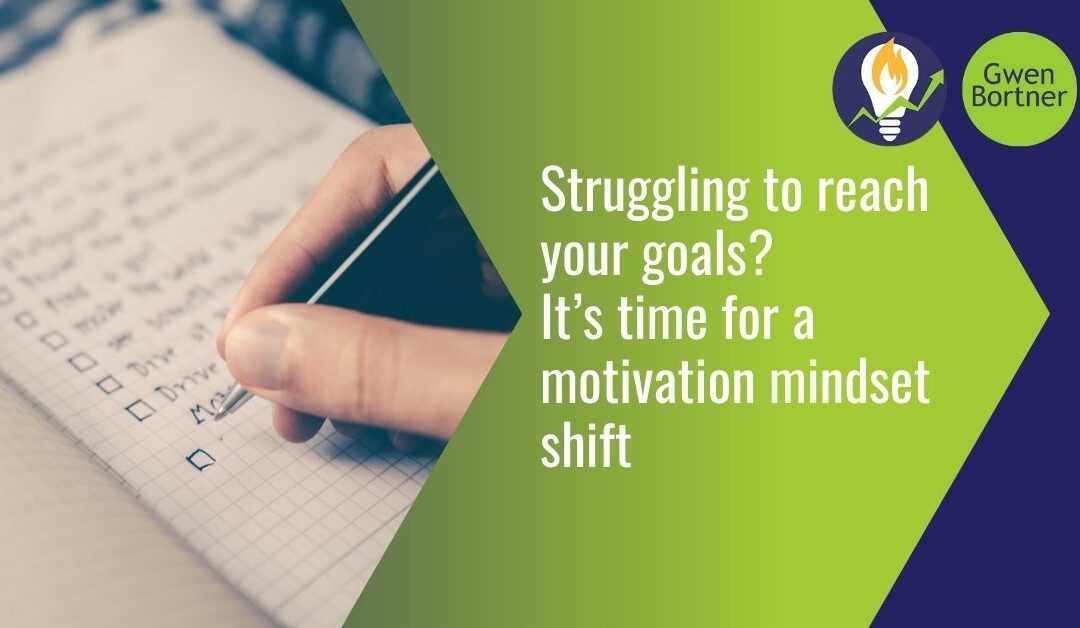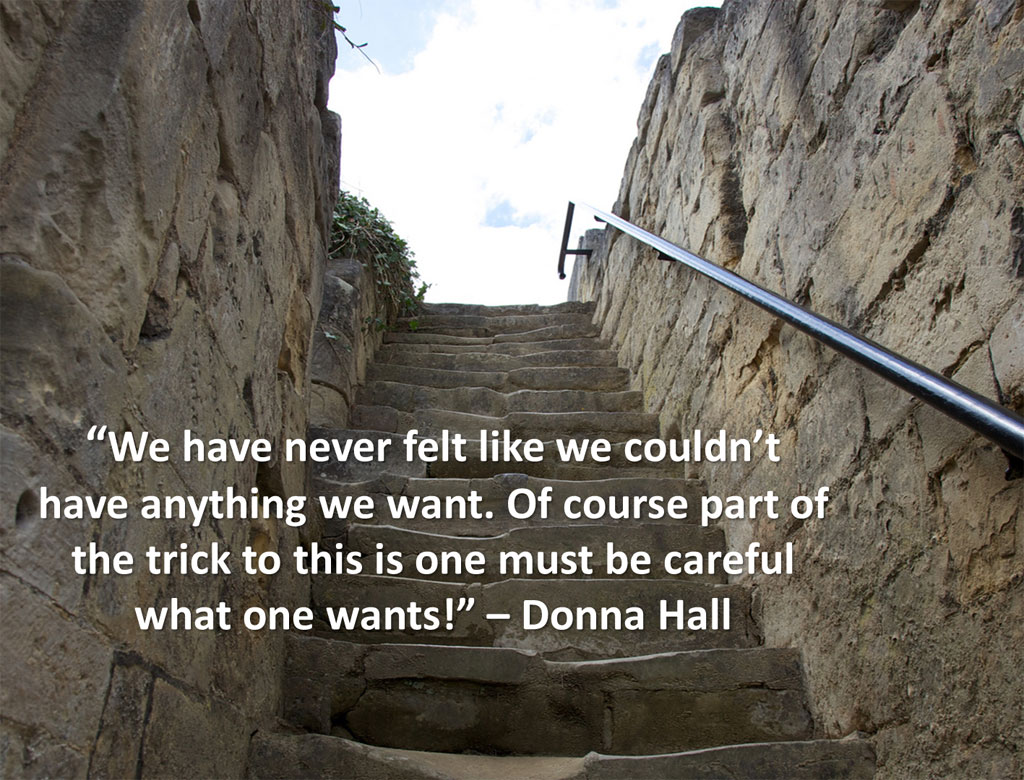
by Gwen Bortner | Tasks & Goals
In my work as a consultant, I talk to my clients about goal-setting all the time. You probably set goals regularly, both formally and informally, but how many of those goals do you actually reach? If you’re having problems in this area, chances are you just need to change your mindset about goal-setting and motivation.
Do any of these scenarios apply to you?
- You set a goal and you feel really excited about it, but only for a short period of time. Eventually, your enthusiasm fizzles out, and you’re left feeling defeated because you couldn’t reach the goal.
- You set a goal but you have no idea how to actually achieve it, so you get overwhelmed and start to think that maybe the goal just isn’t possible for you.
- You feel like you should be setting more goals for your life or business, but you can’t really figure out what those goals should be.
If you saw yourself in any of those scenarios, keep reading, because this post is for you.
Change your WHY
When you set a goal, what is the reason for it? If you can’t think of one, or the reason is because someone else suggested it (you read about it in a blog post, or that’s what “everyone” is doing, or you have seen it work for other people so you assume it will work for you), it may be time to set a new goal. Doing something because that’s what other people expect, or because it seems like the right idea, is rarely going to give you enough motivation to achieve it.
Maybe you DO have a reason for your goal, though. Do you want to earn enough money in your business so you can quit your day job? Do you want to get 100,000 followers on Instagram so you can partner with other brands? Do you want to earn enough money to buy a ski condo for family vacations?
Those are all great goals, and perfectly valid reasons. The problem is, sometimes those reasons just aren’t enough to really motivate you to reach that goal. It’s easy to get comfortable with what you have, which then causes you to lose the motivation to get what you want.
What have you got to lose?
Take the first example – replacing your day job would be great. But that day job, no matter how much you may dislike it, represents a source of security: a regular income and the safety of knowing what to expect every day. When you have that day job, it can be hard to put in the work to build your business to the point where you can replace that income. You might lose the motivation for such a big goal before you actually reach it.
Now think of it this way: what if you suddenly and unexpectedly LOST your day job? In that situation, I bet you’d find a way to grow your business a lot more quickly, wouldn’t you?
To reframe your mindset about motivation, stop thinking of what you want. Instead, think about what you stand to lose if you don’t reach that goal.
Nothing about your circumstances has to change at all, but if you can figure out the stakes in your own situation, it becomes easier to motivate yourself to reach a goal. Find something you don’t want to lose, and you’ll be much more motivated to make a change.
For me, this change came after my dad died. I realized that when he was sick, near the end, it cost my mom a lot of money to provide for his care. I also realized that it would probably cost me even more money in the future to provide for my own medical or elder care needs, because I don’t have children to help support me when I reach that stage in my life. Knowing that I needed to start getting serious about my retirement savings prompted me to make a major change in my business: teaching knitting classes wasn’t going to cut it if I wanted to live out my retirement years in comfort.
Nothing changed about my circumstances when I made this shift in my goals: I have never had (or really wanted) children, so this was not new information. I have always known that my family has given me good genes, so I can expect to live a long time. But it wasn’t until I really thought about these things, and the risk I would take by not making better plans for my retirement, that I really kicked my motivation into high gear.
Think of it this way: most people don’t get serious about their health until they have a medical scare. What’s the “scare” you can give yourself about your business in order to help increase your motivation to grow that business?
The Motivation Equation
Once you’ve got clarity about your goal and the motivation behind it, it’s time to make sure that those two things match up. Here’s an equation I like to use:
M4R > Fe
What this means is that the motivation for your result (M4R) in any goal needs to be greater than the force, energy, or effort (Fe) required to achieve it.
Motivation for the Result (M4R) > Effort to achieve the Result (Fe)
If your goal is too large, and your motivation isn’t enough to help you get there, then you’re going to lose steam and probably fall short of reaching your goal. One way to help with this is to think about what’s at stake if you don’t reach the goal, as I talked about at the beginning of this post. Another option is to make sure you set goals that are manageable, and equal to the amount of motivation you have for them.
Resize Your Goal
If your goal is too large, it can take a lot of time and energy to reach it. Your motivation has to be really strong to reach that kind of goal, and most of us just don’t have that much motivation stored up. If that’s the case for you, then consider breaking your big goal into smaller increments, and set each increment as its own goal. Not only will this help you see progress faster, but it will also give you a chance to take a break along the way, and re-evaluate whether you still want to keep striving toward your initial, larger goal or whether it’s time to go in a different direction.
Instead of earning enough to replace your day job salary for a full year, start by earning enough to replace one month, then three months, six, etc. Instead of earning enough to buy a condo, try saving enough for the down payment, and then see if you can bank the mortgage payment every month for three months. If you don’t have an emergency situation to motivate you, set goals that are more do-able, and then stop to re-evaluate along the way.
Before you set your goals, take a minute to make sure that your motivation matches the amount of work you’re going to have to put in to get there. Reaching a big goal isn’t ever going to be easy, but when you reach those rough patches, remembering your motivation can be a good way to keep yourself on track.
If you’d like some feedback about your goals or some help finding the motivation, click here to book a consultation with me, and I’ll help you figure out how to balance the Motivation Equation for your business.

by Gwen Bortner | Leadership, Tasks & Goals
Are you spending all your time in the day-to-day tasks of running your business, or do you regularly take time to think about what truly matters to you and plan out your overall mission and vision? If you don’t know where you’re going, or have a plan for how to get there, how do you ever expect to grow?
Do you (and everyone who works with you) know what you’re actually trying to accomplish? Have you ever outlined a “mission and vision” statement for your company?
Get Clear on Your Mission
Mission and vision statements aren’t any good if they’re super vague – there needs to be a clear objective. When you write yours, instead of saying things like “strive to provide excellent customer service,” write out your objectives using specific parameters and terms. Think of this as the way you want to do business, the type of company you want to run, and the type of CEO/owner/leader you want to be. Get very specific, and keep it simple. Otherwise, how will you know when you’ve succeeded?
Plan Your Goals
Once you have identified your bigger mission, it’s time to set goals that will help you achieve it. Something I have kept with me from my adventures in the knitting industry was this nugget of wisdom by Cath Kidson:
Stay true to your idea
Learn to say no,
Don’t confuse a distraction for an opportunity,
Trust your gut,
Don’t be afraid to ask for help,
Stay focused (See reference here.)
Remember as you’re setting your goals to always keep your mission statement in mind. For every opportunity that comes your way, hold it up in the light of your mission statement and make sure it’s a good fit before you go running down that path. Stay on top of your current goal, and focus on one thing at a time, to see real progress.
Test the Theory
It’s time to put your mission statement to the test:
- Could it be anybody’s, or is it distinctly yours?
- Ask your employees (if you have them – or consultant/contractors): what is their ultimate goal for your business? How similar are their answers and how close are they to YOUR answer?
- What would your customers say? If you asked them what your goal is, would they even be able to come close?
Once you have provided honest answers to these questions, you may realize that you need to tweak your mission statement to improve it. The process should constantly evolve as you do and as your business grows, so make a point to revisit it once a year and see if any changes need to be made.
By focusing on what’s most important and regularly reminding yourself of your larger goals, you’ll find you actually get where you wanted to go.

by Gwen Bortner | Tasks & Goals
Setting goals is great – it feels so good to think about the future and make plans for the greatness you will achieve in the coming year. The hard part comes when you start looking back at the goals you set, and you realize you haven’t met any of them. Stop letting yourself down – learn how to actually MEET the goals you set so that you don’t have to feel like a failure any more!
Here are my best tips for achieving the goals you set for yourself, whether they’re for life or business or both!
Tip #1: Understand whether or not this goal REALLY matters to you.
Often when we fail to reach a goal, it’s because we gave them lip service but weren’t truly inspired to reach them. We thought we should set the goal but as it turns out, we don’t want to actually work with it. So the first step is to eliminate all the goals that don’t actually matter. Though this may *feel* a bit like failing at those goals, in reality it’s more like de-cluttering your goal list so you can focus on working towards the things that matter most.
Tip #2: Keep your goal count low.
When you set too many goals at once, you’re focusing on too many things and you don’t get any progress made. Even if you have several goals in mind, choose just a few to focus on at any one time so that you can make real progress. It’s better to check off your goals one at a time because you can use that progress to motivate you to work toward the next goal, rather than pushing yourself to work on too many projects at once and feeling like you’re never going to finish anything.
Tip #3: Partner with someone who has similar goals.
This type of relationship is called an accountability partner, and it can be really helpful to work together with someone who has similar goals to your own. The concept is most familiar in the form of a workout buddy but it can be applied to any goal. The key is to work toward supporting one another and not turn it into a competition.
Tip #4: Work with someone who can help to push you toward reaching your goal.
Instead of an accountability partner (someone who has a similar goal), this tip is more about finding an outside person to motivate you to work on your goal. It might be a partner or friend or it could be someone like a business consultant or coach.
Tip #5: Set 3-Level Goals.
Todd Herman suggests you should give yourself goals at 3 levels: good, better, best. For instance: the best-case scenario is that you want to lose 50 pounds, but good would be 10 and better is 25. If you ONLY set the highest-level goal then it often takes too long to reach it and it’s easy to get discouraged. But when you reach the good or better goal then that can even be what motivates you to push to the next level.
Tip #6: Look for the WOW Mindset.
Instead of looking at how far you have to go, you look at how far you have already come. Instead of, “I’ve still got 9lbs to lose,” think of it like, “WOW, I lost a pound already!” Looking at your goals from the mindset of the progress you’ve made rather than what’s left to do is a way to encourage yourself to keep making that progress. (This is another of Todd Herman’s great ideas!)
Tip #7: Avoid the OW Mindset.
Herman’s final contribution to this post is the “OW Mindset,” or the idea that all too often we focus on what’s left to come instead of on how far we have already climbed. This tip is the companion to the last one; avoid thinking of the “pain” of what’s to come and instead focus on the success of what you’ve already achieved.
Tip #8: Recommit to your goals on a regular basis.
Review your progress, make adjustments as needed, and keep moving forward. This is the foundation of making actual progress – the process of checking up on the progress you’ve made and reminding yourself why you wanted to achieve that goal in the first place.
Every quarter I host a group session to help you to do these things – review and plan. Read more about the Quarterly Tune-Up here. Click the Register Now link if you are interested.

by Gwen Bortner | Tasks & Goals
As I began 2017 I reconsidered all of my “start of the new year behaviors” and decided that “simpler is betterer.” (I know it isn’t a word, but it catches your attention)!
Resolutions are OUT, Goals too COMPLICATED
New Year’s resolutions have become passe. Most resolutions are “broken” by mid-month anyway, so why even pretend you are going to set one?
Although I am still a fan of goals, they are not actually simple. As something to give us longer-term, specific or big results, goals are awesome. But to help us make the consistent, sometimes small steps forward, they just are not as useful.
So the question I asked myself this year was: In addition to setting goals, what can I do that will help me stay focused on moving forward, but be so simple I won’t have to struggle with integrating it into my daily life and routine?
One Word
Several years ago my friend and former business partner Kellie shared with me that she picks a word for the year as her focus. She then adds a custom charm (pendant) to her always worn necklace (you can get some ideas here). I liked the concept but didn’t act on it then.
Fast forward to just a few weeks ago and I was introduced to One Word That Will Change Your Life by Jon Gordon, Jimmy Page, and Dan Britton. It is a quick read (or listen) and can help you discover a single word focus for the upcoming year. So I engaged in the process.
Three Words
At around the same time, Chris Brogan wrote about his process of identifying three words for the year. He finds that three words provides a bit more robust focus without over complicating the process. He is adamant that they just be three individual words, not a phrase.
Chris’s process is somewhat different than the One Word process outlined in the book, but I definitely see how it would provide insight and value. Particularly depending upon how your own mental, emotional, and spiritual processes work. Three has always been a favorite number of mine (possibly because I was born on the third).
Four Words
Chris says four words didn’t work for him, but I loved the Four-Word Poem concept I learned last spring from Marlon Hall. It really is more like a mantra, a catch-phrase, or possibly a purpose, but ultimately has some of the same objectives of simplifying focus to ensure forward direction.
As a “logic” person, I like structure, so the simple structure appeals to me. However, it does feel different than either of the two approaches above.
My Answer for Me
I have decided to try all three options out to see what makes the most impact and which, if any, seems to “stick.”
- One Word: Results – I am often busy, but busy isn’t the same as effective and there are many areas in my life that could use some tangible results.
- Three Words: Results, Simplify, Relax – To get results I am going to need to simplify in lots of areas (I have too much going on in too many different facets of my life). But I also need to remember and re-focus on relaxing. Not just “not working” but truly engaging in activities specifically for relaxation.
- Four Words: Inspiring Ideas for Success – This applies not only to myself but also how I interact with others in all the many areas in which I am currently engaged.
Which option appeals to you? One, three, or four words? Or do you have a different option? Share your thoughts in the comments below.







